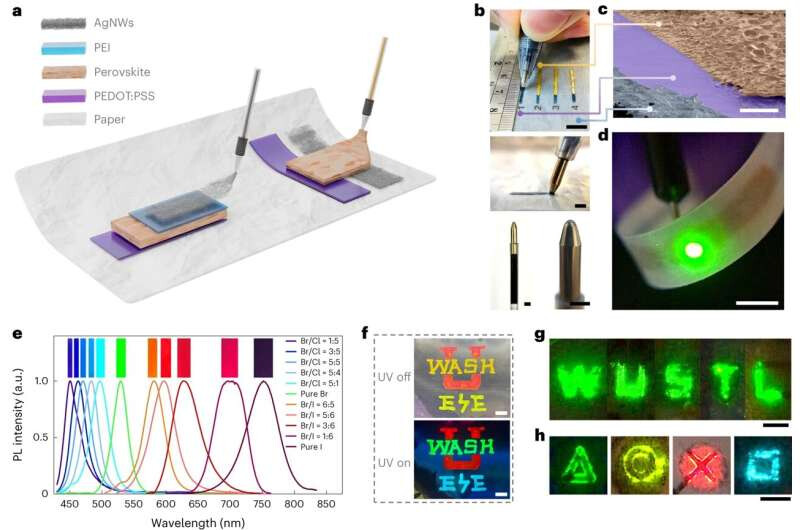The invention of the printing press revolutionized duplication of the written word, giving the hands of tired scribes a break and making written material more accessible. A similar breakthrough has happened in reverse in the McKelvey School of Engineering at Washington University in St. Louis.
Researchers working with Chuan Wang, associate professor of electrical & systems engineering, have developed ink pens that allow individuals to handwrite flexible, stretchable optoelectronic devices on everyday materials including paper, textiles, rubber, plastics and 3D objects. Flexible optoelectronics for emitting and detecting light, which are already found in everyday objects like smartphones and fitness trackers, can bend, fold and flex while maintaining functionality.
In a paper published in Nature Photonics, the team reports their simple and versatile fabrication approach to allow anyone to make a custom light-emitting diode (LED) or photodetector without the need for any specialized training or bulky equipment. The new handheld fabrication technology builds on earlier work by Wang and first author Junyi Zhao, a doctoral candidate in Wang’s lab, in which they demonstrated a novel way to fabricate stretchable LEDs with a simple inkjet printer.
“Handwriting custom devices was a clear next step after the printer,” Wang said. “We had the inks already, so it was a natural transition to take the technology we had already developed and modify it to work in regular ballpoint pens where it could be cheap and accessible to all.”
The Nature Photonics paper is “Handwriting of perovskite optoelectronic devices on diverse substrates”. Here is the abstract.
Paper and textiles that are commonly used in our daily lives hold great potential as platforms for next-generation flexible and wearable electronics. However, strategies for fabricating light-emitting diodes and photodetectors on different substrates are restricted in terms of their quantity and variety as strict flatness and smoothness are often required. Here we develop a highly versatile, scalable and eco-friendly handwriting approach to draw multicolour perovskite light-emitting diodes and perovskite photodetectors on various substrates, including paper, textiles, plastics, elastomers, rubber and three-dimensional objects. Our method uses common ballpoint pens filled with newly formulated inks of conductive polymers, metal nanowires and multiple perovskites for a wide range of emission colours. Just like writing with multicoloured pens, writing layer-by-layer with these functional inks enables perovskite optoelectronic devices to be realized within minutes. This process can be carried out by individuals without specialized training. The handwritten perovskite light-emitting diodes can exhibit a brightness as high as 15225 {\rm cd m}^{−2}, a current efficiency of 6.65{\rm cd A}^{−1} and a turn-on voltage of 2.4 V. The perovskite photodetectors exhibit an on/off ratio of over 10,000 and a responsivity of up to 132 {\rm mA W}^{−1}. This work offers a route to the integration of perovskite optoelectronics in low-cost and large-area application scenarios such as electronic textiles, electronic paper, smart packaging and other disposable electronics and wearables.
The full text is behind a Springer paywall which wants you to cough up US$ 39.95 for a PDF of the paper, which has not yet been liberated by a buccaneer and returned to the taxpayers who funded this research in the U.S. at Washington University in St Louis and Florida State University, with additional funding by the Bill & Melinda Gates Foundation who apparently believe “information wants to be locked up”.
